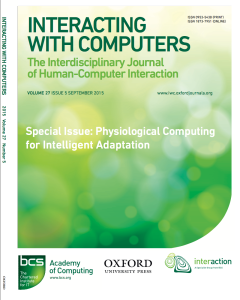I’ve just returned from a summer school on pervasive adaptation organised under the PERADA project. As preparation for my talk, I was asked to identify some future applications for physiological computing. I drew from an idea first articulated by Ros Picard that exposure to quantifiable, objective feedback about emotional states could serve an educational purpose – to aid awareness and self-regulation. Thinking about a future time when wearable sensors are standard and wirelessly connected to phones/PDAs/laptops, I came up with the idea of body blogging. The basic notion here is that you can review a physiological data set collected over a period of time, perhaps synchronised with a diary, and identify trends that might be of interest.
The big changes, such as sleep/wake cycles, are sort of interesting (did you really have a bad night’s sleep?). If you take regular exercise, you might like to know how your body responded to that session at the gym or how many calories you burned during a run. Changes in physiology that relate to health, such as blood pressure, would be very interesting because hypertension tends to be essentially symptom-free, so the technology is providing a window on a hidden aspect of life. Perhaps I’m a little too curious about this stuff, but I’d like to know what kind of activities or contact with people tended to increase physiological markers of stress.
The central concept is to use a monitoring technology as a tool to extend self-awareness and to make changes (in lifestyle or attitude) that counteract those negative influences that are part-and-parcel of everyday life. When I proudly presented the idea, it struck me as a little “niche” and perhaps a little strange – an impression confirmed by the general apathy of the audience. On the next day, I checked my RSS to Wired and came across this article by Gary Wolf who obviously has thought much more about this kind of stuff than me. He even runs a blog in conjunction with Kevin Kelly dedicated to the topic. Encouraged by this apparent serendipity, I brought up the prospect of body blogging again during my second talk of the summer school – but my audience remained distinctly underwhelmed, even though I sensed a small number thought the term ‘body blogging’ was neat.
As part of the health psychology module I teach, I’ve come across research on allostatic load (AL). This is a concept from stress research developed by Bruce McEwen among others; in essence, AL represents the temporal characteristics of how the body responds to a stressor (i.e. the magnitude of the response, recovery time). As you may imagine, high stress reactivity with a slow recovery rate is bad for health. In fact, McEwen and Seeman linked AL to the concept of biological aging – people with higher AL have bodies that age at a faster rate than their chronological rate (and tend to suffer from poor health as a direct consequence). Here’s an article explaining the application of this approach to the effects of socioeconomic status on health. There are several markers of AL including: blood pressure, hip:waist ratio, the hormone cortisol, ratio of high-to-low density lipids (see previous link for more examples).
Which is an extremely long-winded way of wondering if body blogging could help people to track their AL and biological age – and to allow them to develop strategies and habits that minimise the impact of everyday stress on health. The current conception of AL relies heavily on measures taken from plasma samples, so perhaps that is a limiting factor. On the other hand, one problem with trying to sustain healthy lifestyle choices is the absence of clear, unequivocable feedback – so perhaps there is some hope for the concept of body blogging after all.
